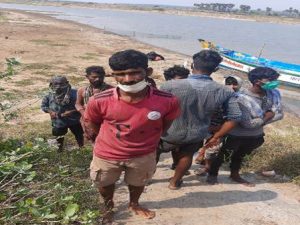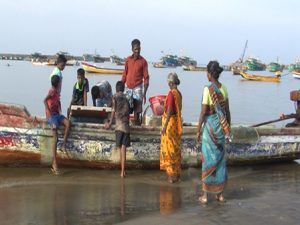COVID-19: Migration of Marine Fish-workers and Misfortunes
The appalling travel of migrant labours to Coastal districts of Odisha along Bay of Bengal through sea route has opened up the issues of law and order and livelihood.

India is under Lockdown for 54 days till May 17. Stringent lockdown measures are there in place to fight against COVID-19 pandemic. But defying all the rules and restrictions, hundreds of migrant fish-workers left Chennai and reached to Odisha by sea route. It is a matter of concern, not only about the loss of livelihood for the poor fishermen but also the possibility of extending COVID-19 disease pathways to the eastern Indian states.
Of late, the influx of travellers back to Tamil Nadu has seen a surge in COVID-19 reporting, contact tracing, treatment and rehabilitation of patients. As on 30 April 2020, Tamil Nadu has 2,162 confirmed cases while 27 deaths have been reported. A couple of days back, the disease incidence was at its peak and created a reverse trend of migration from Chennai to other parts of the country. Odisha’s fishermen are few who defied intelligence and were not intercepted by surveillance agencies.
The population density of Ganjam district is 430 (2011 Census), one of the highest in the state and the hygiene behaviour of people staying are deep-rooted within the culture and tradition. These are the facilitating factors for disease transmission, if the migrant fish-workers reaching tested positive on their arrival. On the contrary, there is hardly any COVID-19 positive cased reported in Ganjam district of Odisha and Disease incidence from where migrant workers come to work.
Marine Fishing along the Coast of India
In Chennai, Royapuram area is reported to have the highest incidence of COVID-19 cases and have been put under containment zones. Within Royapuram, the century-old Kasimedu fishing harbour exists that attracted fishermen, fish sellers and buyers alike. Exotic fishes and marine products are exported to places like Malaysia and Singapore.
Also Read : Migrant Exodus During The National Lockdown
The journey from Royapuram Fishing Harbour to Ganjam coast, avoiding travelling 1,050 km on foot, scarcity of food and water, shelter, police question, border crossing, compulsory quarantine, etc. did not deter the fish-workers. They took the shortest distance on the sea on the coast of Tamil Nadu and Andhra Pradesh before entering into Odisha.
Migrant Labourers Returning Odisha via Sea Route
The horrifying travel of migrant labours to Coastal districts of Odisha along Bay of Bengal through sea route has opened up the issues of law and order. It is difficult to imagine how four boats, loaded with more than 30 people in each boat started reaching Odisha coast.
Traditional marine fishermen attracted to mechanized fishing migrate to far off places like Kakinada, Tuticorin, Chennai, Mangalore, Cochin, Goa, Gujarat and many other coastal cities.
Fearing the complete lockdown announced in Chennai on 20th April and any untoward incidence, the fish-workers of Odisha and Andhra Pradesh started thinking of venturing trough sea route by purchasing second-hand boats.
Table: Details of Fishermen Reaching in Phases Odisha Coast
| Travel Details | Port of Departure | Destination |
| 20 April 2020: 27 fishermen of which 10 were from Odisha and remaining 17 from AP(Rate of boat INR 1.73 lakhs) | Chennai
|
Donkuru, Srikakulam, AP |
| 25 April 2020:38 fishermen of which 29 are Odisha and rest 9 from AP(Rate of Boat: INR 2.00lakhs) | Chennai | PatiSunapur, Chikiti Block, Ganjam, Odisha |
| 27 April 2020: 39 fishermen reached Odisha of which 25 fishermen from Odisha and 14 from AP(Rate of Boat: INR 2.15lakhs) | Chennai | Ramayapatna, Chikiti Block, Ganjam, Odisha |
| 28 April 2020:28fishermen, all from Odisha reached(Rate of Boat: Unspecified) | Chennai | Gopalpur Port jetty, Ganjam, Odisha |
Source:Odisha Traditional Fish Workers Union (OTFWU), Odisha
Another group of Fish-workers are stranded in Mangalore and 36 of them have alreadycrossed1,500 km on land route via Bangalore and reached Srikakulam (Andhra Pradesh); they are yet to reach Ganjam even after they have completed 14-day mandatory quarantine for two more weeks. One of the victims told that because of poor coordination by Odisha and Andhra Pradesh governments, the migrant fish-workers are still languishing in a bordering state. He added there is a scarcity of food and couple of day’s back local police had beaten up stranded fish workers inside the quarantine zone.
Unprepared how to face the situation, the minister has ordered an enquiry into the issue on how the workers travelled such a long distance. The Odisha police, on the arrival of migrant fish-workers, seize the boat and other essentials. The fish-workers are now put in makeshift quarantine centres in Odisha and Andhra Pradesh.
MHA directives on Movement of Persons

Taking cognisance of the complexities of inter-state migration, the Ministry of Home Affairs (MHA), Government of India, in its latest notification (No.40-3/2020-DM-I (A) on 29 April 2020 has allowed migrant workers, among other eligible population to return back home.
The moving persons would be screened and those found asymptomatic would be allowed to proceed. MHA has also mentioned that on arrival at their destination, such persons would be assessed by local health authorities and kept in-home quarantine. A representation has been submitted to the Odisha Government, responding to MHA order.Odisha government, of late, allowed migrant workers of Surat (Gujarat) to return back to Ganjam but the same gesture was not seen for the fish-workers coming either by sea or land routes.
Countering Infodemics and mysterious Ships of Odisha
Odisha was the first state to come up with daily bulletins at 4:30 pm every day, justafter the MHA and MOHFW press conference. It is interesting to know, that the Chief Spokesperson, Subroto Bagchi, has been continuously referring two ships stranded elsewhere with positive COVID-19 cases. In a crisis situation, he was roped in to take lead of administrators, law and order and health professional engaged in COVID-19 containment efforts.
Till that time, it was believed that only land and air spaces were locked; however, the ingression of fish-workers in the territorial water of eastern coast changed the narrative of briefings.
In a way, he was countering infodemics caused by social media and rumours around COVID-19 and means of disease transmission.
The news of sea invaders changed the way normal disease briefing done elsewhere. He started giving details of porous borders with minute geographical details. He started including epidemiological data with infographics to equip frontline workers to be more vigilant on ingression.
Also Read : Covid 19 In India Immense Role For Healthcare Field Workers
Issues and Concerns of Fisher-men
Coastal Odisha, particularly in southern districts, have the poor and inadequate infrastructure to support traditional marine fishermen. The only fishing harbour, Gopalpur in Ganjam district has inadequate ice plant, storage and market facilities for the fish catch. Recurrent disasters of cyclones have been a routine eventin the past decades. Each time when disaster hit Odisha coast, the traditional fishermen were the first to encounter and suffer the most.
Kanda Elleya, General Secretary, Odisha Traditional Fish Workers Union (OTFWU), Ganjam District unit and vice-president of National Fish-workers Forum demands that there should be fishing harbours with all modern facilities. But for the incoming fish-workers, he demanded that stranded fish-workers be repatriated with hygienic living condition, food, cash and psychosocial support.
The issues of traditional fish-workers are deep rooted in negligence of the sector and aspirations of youth. In order to address to the impending situation, Alleya stressed on a comprehensive study of themarine fishing value chain, processing of marine products and biosafety issues and of course skilling and entrepreneurship of younger generation fishing community.
Skilling and Employment
Odisha is a pioneer in livelihood promotion and skill development in the country and has established institutions like Odisha Livelihood Mission (OLM) and Odisha Skill Development Authority (OSDA). But,it is surprising on how the marine fishing population became excluded from the radar of the state.In the absence of any credible information on the number and places of migrant workers, the government had to declare online portal, where migrant workers would fill in details of their place of work, domicile and other demographic details. It is estimated by the State government that around 5.0 lakh stranded migrant labours are in different parts of the country. The Bay of Bengal has shaped up the life and livelihoods of people around the sea for centuries. In his book, Sanjeev Sanyal, who happens to be the Principal Economic Adviser to Government of India, mentioned the entrepreneurship and courage of the seafaring population across the sea.
